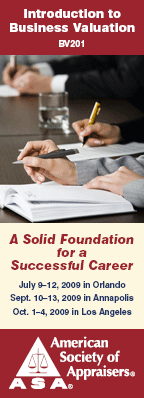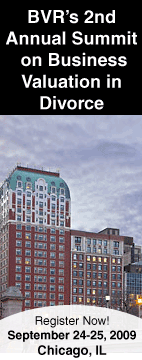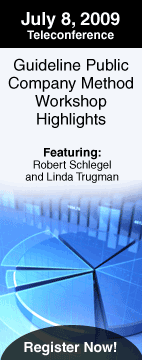| Laro/Hitchner qualify DLOM models and methods
We have continued to receive more responses to the BVWire™ item that quoted U.S. Tax Court Judge David Laro as having become “well-acquainted with the five models most commonly used to calculate marketability discounts.” Understandably, the impartial judge threw out a quick lifeline to a “real” expert, Jim Hitchner of the Financial Valuation Group, who will serve as moderator of this October’s 2nd Annual University of San Diego School of Law, Business Valuation and Tax Conference, which will cover all the well-known models in detail and may address some newer ones. Hitchner believes there are currently five major types of DLOM analyses:
- IPO studies;
- Restricted stock studies;
- Bajaj-type analysis;
- Option pricing; and
- QMDM (Quantitative Marketability Discount Model).
“A Mandelbaum type analysis could be a sixth method, but I think it really pulls things together after the application of other models,” he adds. “The IPO studies can be broader benchmark analyses or detailed using the Brian Pearson database Valuation Advisors’ Lack of Marketability Discount Study™. The restricted stock studies can also be broader benchmark analyses or more detailed using The FMV Restricted Stock Study™. Option models have been used for years,” Hitchner continues, “but Longstaff's version is gaining recognition. QMDM is a separate method. In terms of LEAPS, they are gaining in visibility. At this year’s DLOM Summit, we are including a category called ‘other,’ and we may decide to cover LEAPS and also the NICE model.”
An appraisal that ignores market evidence is not an appraisal at all
Public company trades are the best fundamental barometers of general market conditions that we have. And the Guideline Public Company Method (GPCM) is one of the tools BV experts can use to capture the effect of today’s volatile economy on the value of an appraisal target, Rob Schlegel explained at BVR’s recent Guideline Public Company Workshop. With this in mind, today (July 8) at 10:00am Pacific/1:00pm Eastern, Schlegel and Linda Trugman of Trugman Valuation Associates, Inc., will discuss this and other topics in a presentation of “Guideline Public Company Workshop Highlights.” This very special teleconference will feature highlights of Rob’s recent presentation followed by a live discussion of case studies, Q&A, and compelling commentary. Two CPE credits are available to all registrants. Click here to register or get more information.
Top five tips for excelling as an expert witness
Calculating damages in litigation is a specialty within business valuation, which is really to say it’s a niche within a niche—and it’s one that many BV professionals are eyeing as a potential growth opportunity, especially now, when a litigation boom looks certain during these times of economic bust. There is much to be said about having solid business appraisal experience to assist you in determining damages. “But it gets you nowhere if you do not adhere to the Federal Rules of Civil Procedure, or if your conclusions are thrown out due to a successful Daubert challenge," says Bo Brustkern, principal of Arcstone Partners in Denver, Colorado.
“Both the expert appraiser and the trial attorney must keep a number of key factors in mind when establishing damages calculations in a case,” says Brustkern, who just finished two intensive expert witness training programs in Chicago, a day-long American Society of Appraisers course and the National Association of Certified Valuation Analysts week-long litigation boot camp. His top five takeaways from the training could help define or refine your efforts to excel as a litigation expert:
Expert witness report serves as direct testimony. A strict interpretation of Rule 26(a)(2)(b) of the Federal Rules of Civil Procedure limits evidence introduced in court to that which is actually written or displayed in the report. That means your report must be court-ready and contain all the content needed to establish (or refute) alleged damages.
- Prioritize your information request. In a perfect world, all of the data you request to calculate damages will be available and delivered on a timely basis. Practically speaking, however, prioritize your requests by importance. Establishing damages will be difficult, if not impossible, if that essential information is unavailable.
- Read the depositions and interrogatories. They provide invaluable information about the case, and will help refine your understanding of damages. The result will be a more robust opinion and a more thorough and defensible report.
- Daubert challenges are both real and unpredictable. Even the most respected business appraisal experts have lost Daubert challenges. Don’t underestimate the possibility of your report being thrown out.
- Be the educator. Litigation can be a long, complicated adversarial “truth contest,” and the jury desperately wants someone they can trust: They want a witness for the truth. However, the truth will not appear on its own; expert witnesses must “reveal” it in their testimony and their reports. So do great work. Follow the rules flawlessly. Then stand by your work, speak clearly and confidently, and you will do well by judge and jury.
Subsequent events can have a huge impact on IP value
Think of Michael Vick's indictment in 2007. It is this understanding that prompts Mike Pellegrino to include probability distributions to account to some degree for the likelihood of subsequent events in his valuations. Pellegrino explained at last month’s teleconference, Valuing Intellectual Property in Entertainment and the Arts with Kevin Yeanoplos and Bill Sipes: “You can go out and measure the possibility of impairment or beneficial gain. For instance, we know statistically that 71 percent of patents do not go forward, or that lawsuits or copyright infringements occur a percentage of the time. So, we can do a reasonable probability distribution to see both the effect of possible impairment or the likelihood that some one takes your unknown YouTube song and uses it on a TV show—including the value of any statutory damages,” he says. The lesson: Your client does not have to be famous to derive significant value from their artistic efforts.
What keeps CPA firm leaders up at night? The same issues that concern BV experts
Not surprisingly, the economy ranks high on the list. However, it is not all gloom and doom, new data from the American Institute of Certified Public Accountants (AICPA) show. The CPA firms surveyed reported that the biggest issues confronting them as a result of the economic crisis are strains on accounts receivable and revenue reductions because of client attrition and fee pressure. Twenty-four percent of sole practitioners, 19 percent of firms with two to five professionals, 18 percent of firms with six to 10 professionals, and 22 percent of firms with 11 to 20 professionals said the current economic situation has had no impact on their business. More than 10 percent of CPA firms with 10 or fewer professionals are actually seeing additional client opportunities because of the recession.
Interestingly, CPA employment is expected to remain steady with 83 percent of sole practitioners, 75 percent of firms with two to five professionals, 56 percent of firms with six to 10 professionals, and 49 percent of firms ranging from 11 to 20 professionals expecting no increase or decrease in staffing. The complete results of the AICPA’s 2009 CPA Firm Top Issues Survey will include information on client retention, succession planning and marketing to new clients; all great areas of insight for BV experts in need of ideas to emulate.
The IVSC launches new expert group
The International Valuation Standards Council’s (ISVC) new expert group—comprised of 14 leading experts drawn from around the world—will advise the IVSC Boards on the valuation of financial assets and liabilities, assist in developing relevant standards and guidance, and examine the types of guidance needed to avoid some of the difficulties that have been highlighted by the financial crisis.
The members of the new Expert Group are: Mahdi Amri, senior manager, Deloitte, Canada; Ana Castaneda, general manager, InterMoney Valora Consulting S.A, Spain; James Chang, partner, PricewaterhouseCoopers’ Financial Risk Management Advisory practice, New York; Tanguy Dehapiot, head of valuation, market and liquidity risk, BNP Paribas; Christopher Dias, principal, KPMG LLP, Financial Risk Management, New York; Bernard Dumas, Swiss Finance Institute professor of finance, Université de Lausanne; Darryll Hendricks, managing director and head of risk methodology for UBS Investment Bank, New York; Peter Jones, Standard and Poor’s—global head of valuation scenario services, Fixed Income Risk Management Services, UK; Dr. Cindy Ma, managing director, Houlihan Lokey, New York; Manish Saxena, associate vice president, American Appraisal India Pvt. Ltd; Daniel Sommer, partner, Advisory Financial Risk Management KPMG, Germany; Li Xiaoqiang, division director, Chief Accountant’s Office, China Securities Regulatory Commission; and Qingji Yang, principal, Financial Services Office, Ernst & Young, New York.
Ian Blance, principal of an independent consulting practice in the UK, will act as technical consultant to the group. In addition, a member of the International Accounting Standards Board will serve as an observer to the group. The first meeting of the group took place in London last month and it is scheduled to report to the Board by the end of the third quarter.
To ensure this email is delivered to your inbox,
please add editor@bvwire.com to your e-mail address book.
We respect your online time and privacy and pledge not to abuse this medium. To unsubscribe to BVWire™ reply to this e-mail with 'REMOVE BVWire' in the subject line or click here. This email was sent to %%emailaddress%%
Copyright © 2009 by Business Valuation Resources, LLC
BVWire™ (ISSN 1933-9364) is published weekly by Business Valuation Resources, LLC
Editorial Staff | Advertise in the BVWire | Copyright Notice
|





